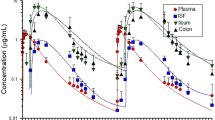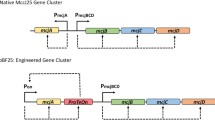Abstract
The effects of the β-agonist ractopamine, approved for use in finishing swine and cattle to improve carcass quality and performance, were examined on two important foodborne pathogens, Escherichia coli O157:H7 and Salmonella. Ractopamine, administered to sheep before and after oral inoculation with E. coli O157:H7, increased (P < 0.01) fecal shedding and tended to increase (P = 0.08) cecal populations of the challenge strain. Pigs receiving ractopamine in the diet and then experimentally infected with Salmonella Typhimurium, had decreased (P < 0.05) fecal shedding and fewer (P = 0.05) liver samples positive for the challenge strain of Salmonella. Pure cultures of E. coli O157:H7 (used in the present sheep study), E. coli O157:H19 (isolated from pigs with postweaning diarrhea), Salmonella Typhimurium (used in the present pig study), and Salmonella Choleraesuis were incubated with varying concentrations of ractopamine to determine if ractopamine has a direct effect on bacterial growth. No differences in growth rate were observed for either strain of E. coli or for Salmonella Typhimurium when incubated with increasing concentrations of ractopamine. The growth rate for Salmonella Choleraesuis was increased with the addition of 2.0 μg ractopamine/ml compared with the other concentrations examined. Collectively, these results indicate that ractopamine may influence gut populations and fecal shedding of E. coli O157:H7 and Salmonella. Because ractopamine is currently approved to be fed to finishing cattle and swine immediately before slaughter, any potential for decreasing foodborne pathogens has exciting food safety implications.


Similar content being viewed by others
Literature Cited
Buzby JC, Roberts T, Jordan Lin CT, et al. (1996) Bacterial food-borne disease–Medical costs and productivity losses. USDA-ERS Report No. 741
Fedorka-Cray PJ, Dargatz DA, Thomas LA, et al. (1998) Survey of Salmonella serotypes in feedlot cattle. J Food Prot 61:525–530
Elder RO, Keen JE, Siragusa GR, et al. (2000) Correlation of enterohemorrhagic Escherichia coli O157 prevalence in feces, hides, and carcasses of beef cattle during processing. Proc Natl Acad Sci U S A 97:2999–3003
Edrington TS, Hume ME, Looper ML, et al. (2004) Variation in the faecal shedding of Salmonella and E. coli O157:H7 in lactating dairy cattle and examination of Salmonella genotypes using pulsed-field gel electrophoresis. Lett Appl Microbiol 38:366–372
Gansheroff LJ, O’Brien AD (2000) Escherichia coli O157:H7 in beef cattle presented for slaughter in the U.S.: Higher prevalence rates than previously estimated. Proc Natl Acad Sci U S A 97:2959–2961
Dickson JS, Hurd HS, Rostagno MH (2003) Salmonella in the pork production chain. Clive, IA, National Pork Board
Sperandio V, Torres AG, Giron JA, et al. (2001) Quorum sensing is a global regulatory mechanism in enterohemorrhagic Escherichia coli O157:H7. J Bacteriol 183:5187-5197
Sperandio V, Torres AG, Jarvis B, et al. (2003) Bacteria-host communication: The language of hormones. Proc Nat Acad Sci U S A 100:8951–8956
Lyte M, Frank CD, Green BT (1996) Production of an autoinducer of growth by norepinephrine cultured Escherichia coli O157:H7. FEMS Microbiol Lett 139:155–159
Lyte M, Erickson AK, Arulanandam BP, et al. (1997) Norepinephrine-induced expression of the K99 pilus adhesion of enterotoxigenic Escherichia coli. Biochem Biophys Res Commun 232:682–686
Freestone PP, Williams PH, Haigh RD, et al. (2002) Growth stimulation of intestinal commensal Escherichia coli by catecholamines: A possible contributory factor in trauma-induced sepsis. Shock 18:465–470
Ricks CA, Baker PK, Dalrymple RH (1984) Use of repartitioning agents to improve performance and body composition of meat animals. Proc Reciprocal Meat Conf 37:5–11
Moody DE, Hancock DL, Anderson, DB (2000) Phenethanolamine repartitioning agents. In: D’Mello JPF (ed) Farm animal metabolism and nutrition. New York, NY, CAB Int, pp 65–95
Anderson DB, Veenhizen EL, Waitt WP, et al. (1987) Effect of ractopamine on nitrogen retention, growth performance and carcass composition of finisher pigs. J Anim Sci 65(Suppl. 1):130
Watkins LE, Jones DJ, Mowrey DH, et al. (1990) The effect of various levels of ractopamine hydrochloride on the performance and carcass characteristics of finishing swine. J Anim Sci 68:3588–3595
Mersmann HJ (1998) Overview of the effects of B-adrenergic receptor agonists on animal growth including mechanisms of action. J Anim Sci 76:160–172
Edrington TS, Callaway TR, Genovese KJ, et al. (2005) Ractopamine supplementation decreased fecal shedding of E. coli O157:H7 in naturally-infected beef cattle. Proceedings of the 2005 Conference on Gastrointestinal Function, Chicago, IL, p 17
Kudva IT, Hatfield PG, Hovde CJ (1995) Effect of diet on the shedding of Escherichia coli O157:H7 in a sheep model. Appl Environ Microbiol 61:1363–1370
Chapman PA, Siddons CA, Harkin MA (1996) Sheep as a potential source of verocytotoxin-producing Escherichia coli O157. Vet Rec 138:23–24
Cornick NA, Booher SL, Casey TA, et al. (2000) Persistent colonization of sheep by Escherichia coli O157:H7 and other E. coli pathotypes. Appl Environ Microbiol 66:4926–4934
Naylor SW, Low JC, Besser TE, et al. (2003) Lymphoid follicle-dense mucosa at the terminal rectum is the principal site of colonization of enterohemorrhagic Escherichia coli O157:H7 in the bovine host. Infect Immun 71:1505–1512
Author information
Authors and Affiliations
Corresponding author
Additional information
Mention of trade names, proprietary products, or specific equipment does not constitute a guarantee or warranty by the United States Department of Agriculture and does not imply its approval to the exclusion of other products that may be suitable.
Rights and permissions
About this article
Cite this article
Edrington, T.S., Callaway, T.R., Smith, D.J. et al. Effects of Ractopamine HCl on Escherichia coli O157:H7 and Salmonella In Vitro and on Intestinal Populations and Fecal Shedding in Experimentally Infected Sheep and Pigs. Curr Microbiol 53, 82–88 (2006). https://doi.org/10.1007/s00284-006-0019-4
Received:
Accepted:
Published:
Issue Date:
DOI: https://doi.org/10.1007/s00284-006-0019-4




